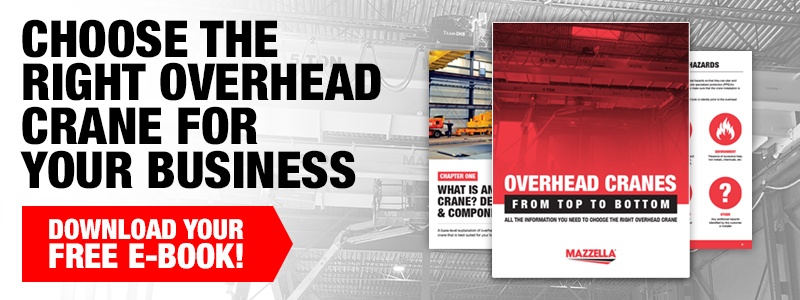Overhead Crane Types, Design, and Installation: A Comprehensive Guide
Menu
Which Overhead Crane Service Class is Best for Your Business?
What is an Overhead Crane?
What are the Different Types of Overhead Cranes?
Purchasing an Overhead Crane: From Consultation to Installation
How to Compare Overhead Crane Quotes
What is the Cost of an Overhead Crane?
Top 10 Reasons to Consider Financing Your Overhead Crane Equipment
Overhead Crane Installation Procedures: From Conception to Completion
Questions About An Overhead Crane System? Contact A Specialist!
Section 1
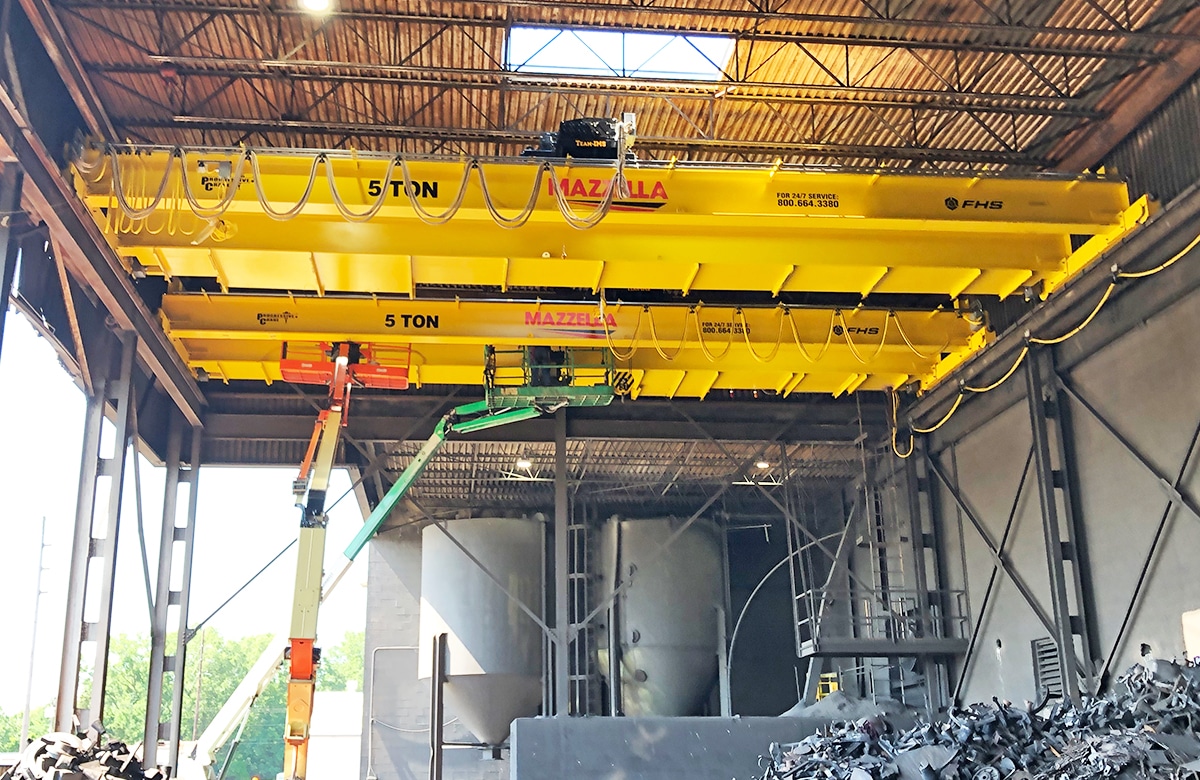
Which Overhead Crane Service Class is Best for Your Business?
There are six (6) different classifications for overhead cranes, specified by the Crane Manufacturers Association of America (CMAA). Each CMAA crane classification takes the following criteria into consideration:
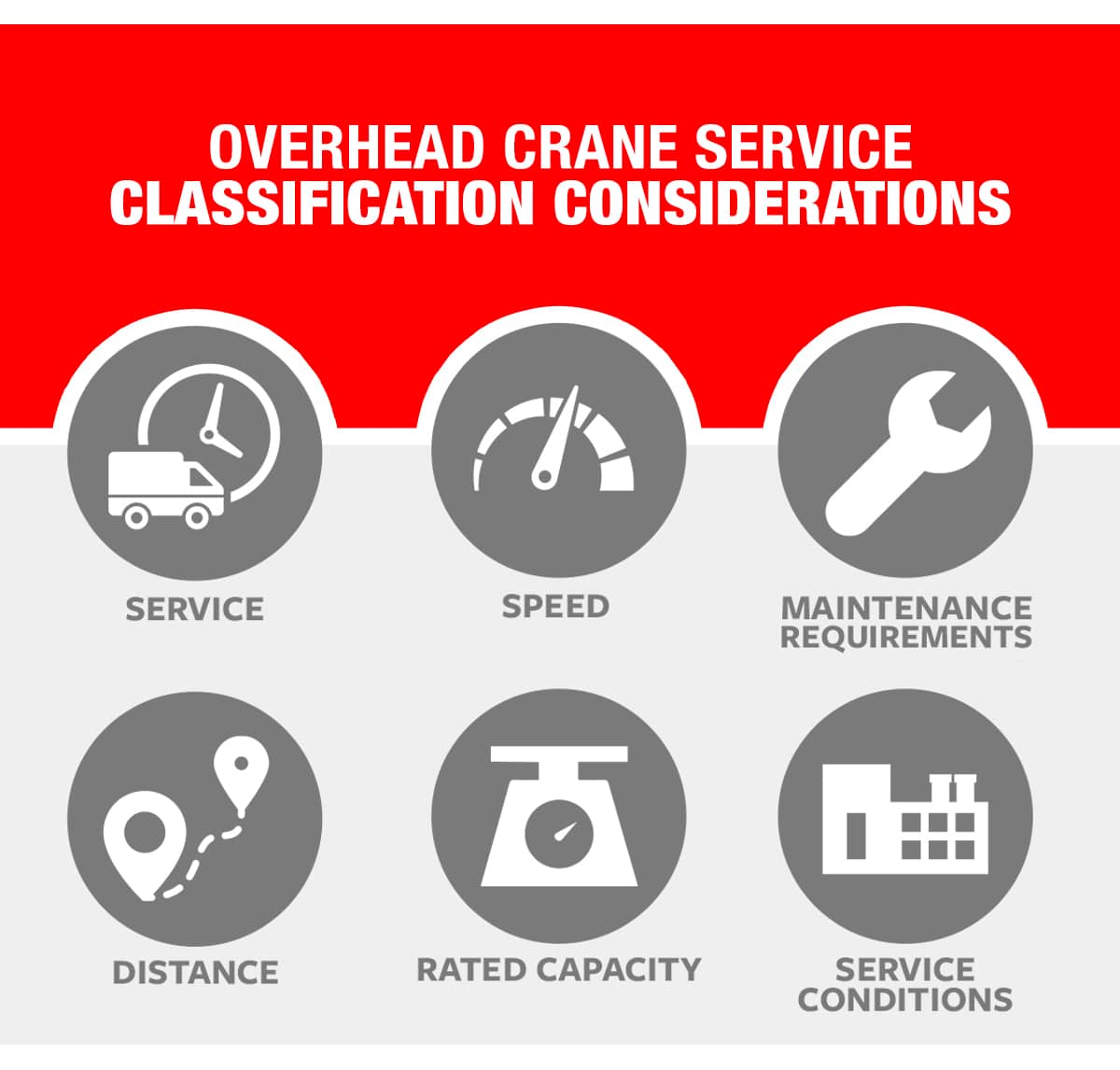
Service:
How frequently will the crane be used?
Speed:
How quickly can the crane transfer materials or equipment? How many lifts per hour can the crane perform?
Maintenance Requirements:
Will the crane need to be serviced regularly?
Distance:
How far does the crane need to move material in your facility?
Rated Capacity:
What is the average rated load of the materials that your crane will be moving? How often will the crane be lifting fully-rated loads?
Service Conditions:
What type of environment will the crane be operating?
Different Types of Overhead Crane Classifications
If you can answer or define each of the criteria above, it will be much easier to determine the type of crane system that works best for your business or industry. Below we’ll identify and define the six types of overhead crane classes and provide types of businesses or industries that match up the best with each classification.
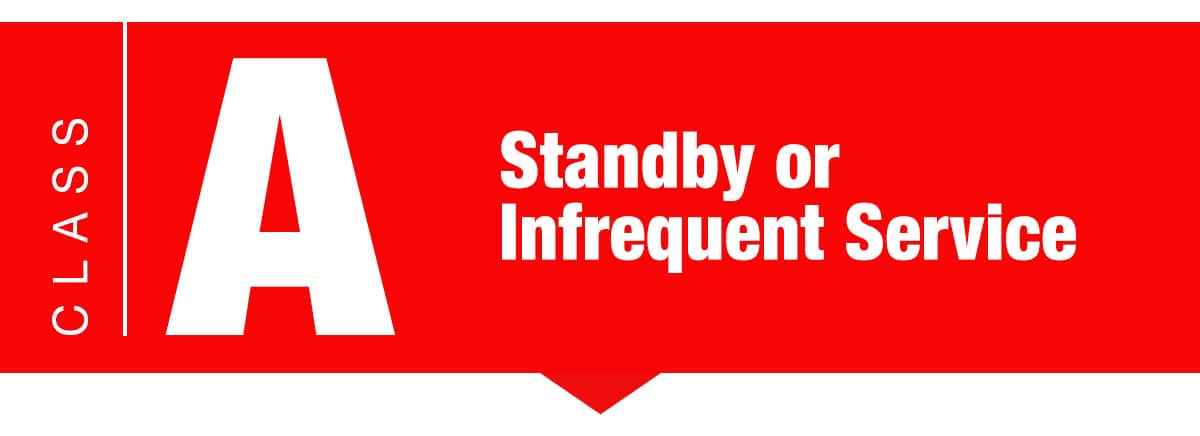
CRANE CLASS A (STANDBY OR INFREQUENT SERVICE)
This service class covers cranes where precise handling of equipment at slow speeds with long idle periods between lifts are required. Capacity loads may be handled for the initial installation of equipment and for infrequent maintenance. Typical examples are cranes used in powerhouses, public utilities, turbine rooms, motor rooms, and transformer stations. This is the lightest crane as far as the duty cycle is concerned.

CRANE CLASS B (LIGHT SERVICE)
This service class covers cranes where service requirements are light and the speed is slow. Loads may vary from no load to occasional full-rated loads with 2 to 5 lifts per hour, averaging 10 feet per lift. Typical examples are cranes in repair shops, light assembly operations, service buildings, light warehousing, etc.

CRANE CLASS C (MODERATE SERVICE)
This service covers cranes where service requirements are deemed moderate, handling loads which average 50 percent of the rated capacity with 5 to 10 lifts per hour, averaging 15 feet, with not over 50 percent of the lifts at rated capacity. Typical examples are cranes used in machine shops, paper mill machine rooms, etc.

CRANE CLASS D (HEAVY SERVICE)
In this type of service, loads approaching 50 percent of the rated capacity will be handled constantly during the work period. High speeds are desirable for this type of service with 10 to 20 lifts per hour averaging 15 feet, with not over 65 percent of the lifts at rated capacity. Typical examples are cranes used in heavy machine shops, foundries, fabricating plants, steel warehouses, container yards, lumber mills, etc., and standard duty bucket and magnet operations where heavy-duty production is required.

CRANE CLASS E (SEVERE SERVICE)
This type of service requires a crane capable of handling loads approaching the rated capacity throughout its life with 20 or more lifts per hour at or near the rated capacity.
Typical examples are magnet, bucket, magnet/bucket combination cranes for scrap yards, cement mills, lumber mills, fertilizer plants, container handling, etc.

CRANE CLASS F (CONTINUOUS SEVERE SERVICE)
In this type of service, the crane must be capable of handling loads, approaching rated capacity continuously under severe service conditions throughout its life. Typical examples are custom-designed specialty cranes essential to performing the critical work tasks affecting the total production facility, providing the highest reliability with special attention to ease of maintenance features.
Components of an Overhead Crane System
In order to get a better understanding of some terms we’ll be using later when we describe the different types of cranes, we’ll discuss the different parts and components, and how they can affect performance and design.
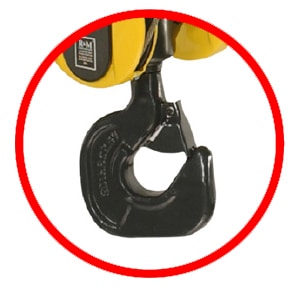
Hook
The lifted load is supported using a hook which connects to the hoist.
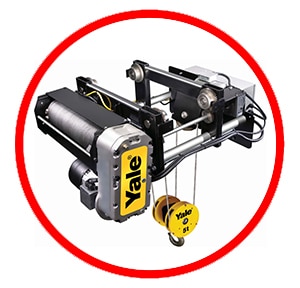
Hoist
The hoist is what makes the lift and holds, raises, or lowers the load using wire rope or chain. Hoists can be powered manually (by hand), with electricity, or with compressed air (pneumatic).
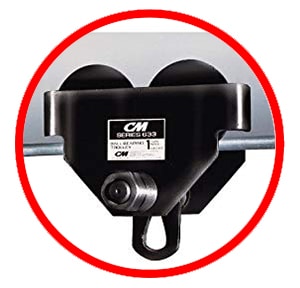
Trolley
The trolley supports the hoist and moves horizontally along the crane bridge, to position the hoist and hook, prior to picking up or lowering a load. Trolleys can be configured in and Under Running or Top Running design.
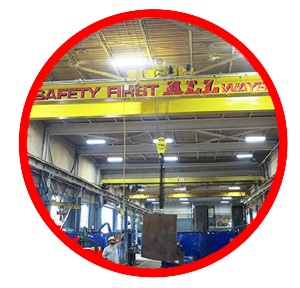
Bridge
A load-bearing beam that runs the width of the building. This is the primary structural component that connects the runways and moves the hoist forward and backward using a trolley. A bridge can be comprised of one or two beams that run the width of the building. This is the primary structural component that connects the runways and moves the hoist forward and backward using a trolley.
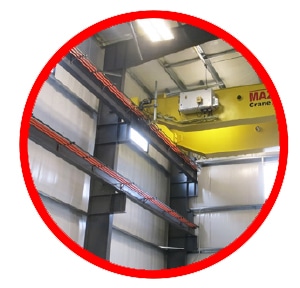
Runway
What the bridge crane travels on to move the crane up and down the bays. These are typically part of the building structure, as beams, and there are two (2) per overhead bridge crane system.
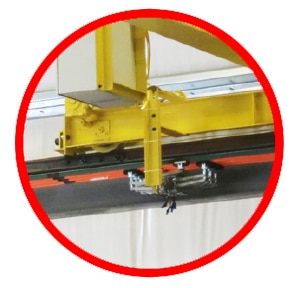
Runway Rail or Tracks
Rail supported by the runway on which the crane travels. Top-running cranes typically run on ASCE/railroad rails. Gantry cranes can also utilize a rail or track system installed in the floor to move the bridge back and forth.
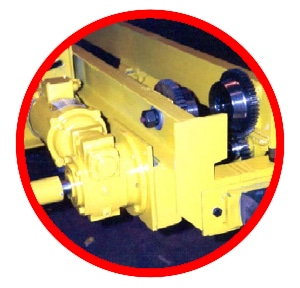
End Trucks
Located on either side of the bridge, the end trucks move the bridge up and down the runway utilizing a series of wheels that ride on the rail. Each end truck can have a configuration of 2, 4, or 8 wheels based on the crane’s capacity.
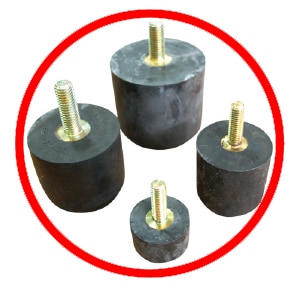
Bumpers
Bumpers are designed to absorb the crane’s energy and reduce impact—bringing the crane to rest in a controlled manner and minimizing forces where the crane or trolley reaches the end of its travel. Bumpers can be attached to the bridge, trolley, or runway stop.
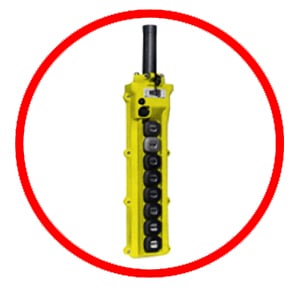
Controls
Controls are typically mounted in a panel on the crane or hoist and the pendant or remote radio console allows the operator to run the crane. The controls operate the drive and hoist motors, and can control the Variable Frequency Drives (VFDs) to control hoist speed for precise load positioning.
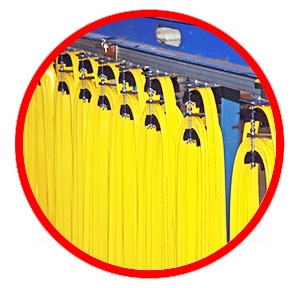
Electrification
Insulated conductor bars or festoon systems (flat cables) bring power to the crane from the building.
If you put a little bit of thought and consideration into how often you will be using an overhead crane, how hard crane system will have to work, and the type of environment that your crane will be working in, you can get a pretty good sense of what type of crane class will be best for your business or facility.
» Learn More About Overhead Crane Classifications!
» Back to Menu
Section 2
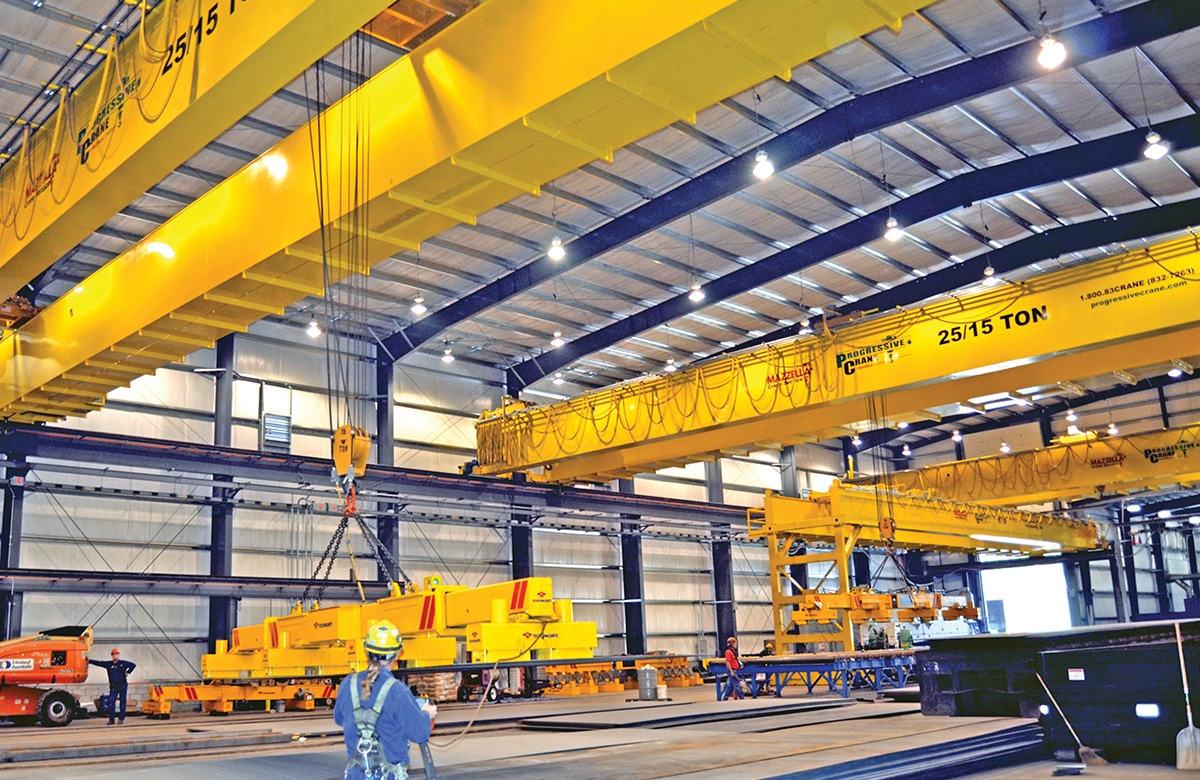
What is an Overhead Crane?
In the simplest of terms, an overhead crane is a machine, or piece of equipment, that allows you to lift and move heavy materials from one location to another in a precise manner.
There is no “one size fits all” approach to defining one, as each crane system is carefully designed and engineered for a specific purpose or application to suit a business’ material handling needs.
Crane systems can be designed and built in all kinds of configurations, and different components can be swapped out or engineered to improve its capacity and performance. Some of the most popular reasons for using an overhead crane include:
- Loading or unloading materials from a truck
- Moving materials around a facility more efficiently than a tow motor or manpower can
- Flipping or pulling dies in and out of stamping machines at a manufacturing facility
- Feeding raw material into a machine at a manufacturing facility
- Moving pieces or parts down an assembly line in a controlled fashion
- Moving containers around a shipyard or railyard
Two Main Reasons to Install an Overhead Crane System
1. Efficiency
They’re more efficient than using a group of workers or tow motors to lift and move material and can work up to 2-3 times faster. Think about how a manufacturer, mill, or
warehouse can streamline their processes and procedures by introducing an overhead crane to automate the lifting, maneuvering, and unloading of materials at their facility.
2. Safety
Cranes can be used to lift and move materials in extreme environments and can handle corrosive or dangerous materials like hot metals, chemicals, and heavy loads. A workstation crane or jib crane can be put in place to help workers move heavy objects in a controlled manner and help cut down on repetitive motion injuries and muscle strains.
Benefits of Using an Overhead Crane:
- Reduction in workplace accidents
- Reduction of product or material damage
- Improved workflow
- Lowered costs
- Green solution that reduces environmental impact
» Learn More About Overhead Cranes and Crane Components!
» Back to Menu
Section 3
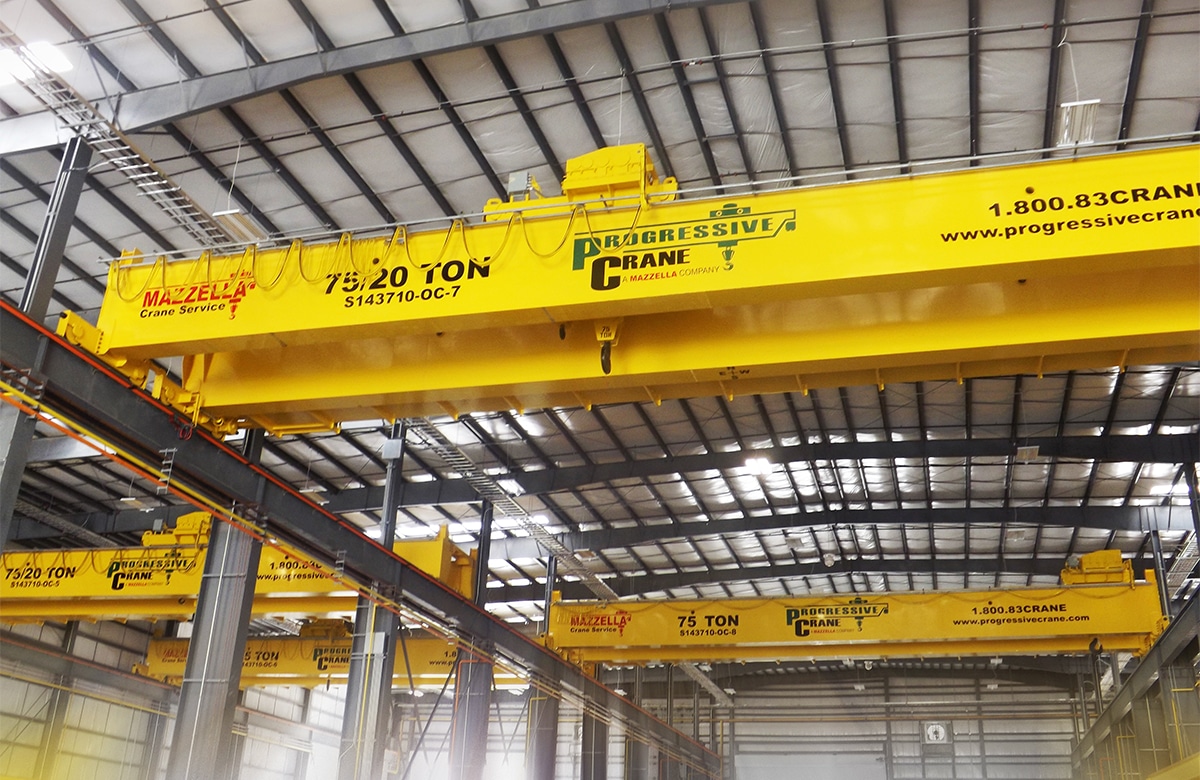
What are the Different Types of Overhead Cranes?
If you’ve done your research and determined that an overhead crane system could improve your facility’s production or material handling processes, then you’re probably beginning to realize that there are all different types of cranes. Your head may be swimming trying to sort through all of the information that is available, and you may be asking yourself, “What type of crane do I need for my business?”
Overhead cranes can vary so much in terms of specifications and configurations. No two crane builds are exactly alike! A crane that worked in a similar building structure, or similar lifting application, may not be the best crane for your facility or your application. So, selecting the right type of crane for your business is critical to maximizing efficiency, streamlining workflow, and getting the best bang for your buck.
What is an Overhead Bridge Crane?
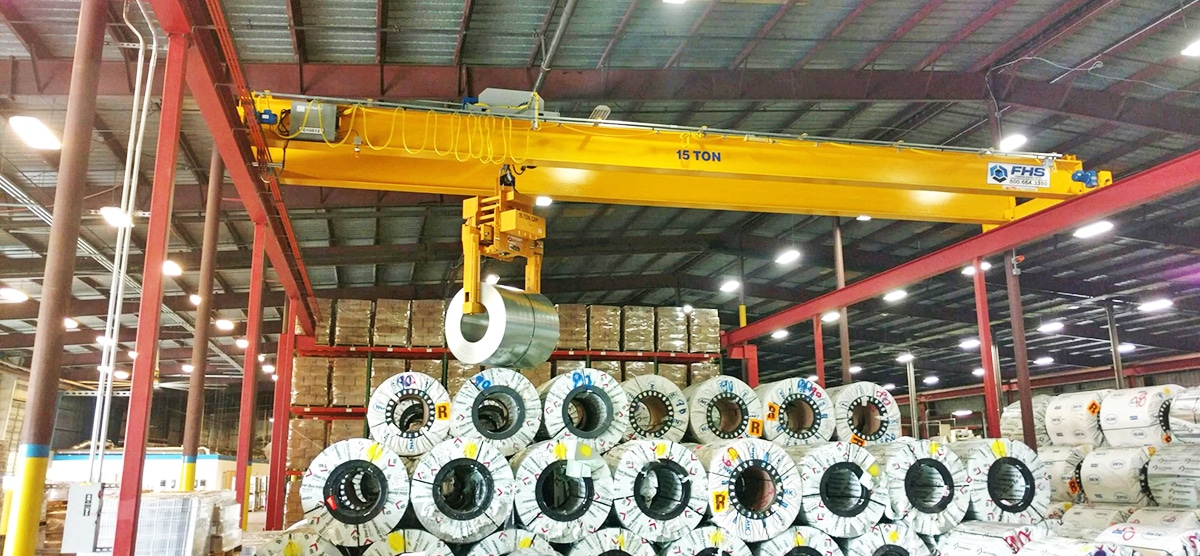
You can probably picture a bridge crane in your head—it consists of two overhead runways built into the building’s support structure, connected by a single or double beam configuration, called a “bridge.” The bridge is supported on either end by an end truck, which rides on wheels along a runway or beam—allowing it to move up and down the bay.
A bridge crane can be configured in a single girder or double girder design. In simple terms, a bridge girder, or beam, is the support structure that allows the trolley and hoist to move from side-to-side along the bridge. The trolley is used to precisely position the hoist prior to raising or lowering a load.
Single Girder Bridge Cranes
The bridge consists of one girder beam supported on each side by an end truck. The trolley and hoist are most commonly underhung—meaning they run on the bottom flange of the bridge. They also tend to be less expensive due to:
- Only one girder is required to move the trolley
- Reduction in freight expenses
- Faster installation
- Simpler hoist and trolley design
However, in the instance that a crane needs to handle more than 15 tons, or the span is more than 65 feet, a double girder configuration may be the better option.
Double Girder Bridge Cranes
There are two girder beams that make up the bridge, and they are supported by an end truck on each side. The trolley and hoist run on a rail installed on top of the bridge girders.
Double girder cranes are recommended for heavier-duty applications where the crane has to handle more than 15 tons, or the span is more than 65 feet.
Double girder cranes are the best option when the crane needs to be customized with things like walkways, cabs, magnet cable reels, or other specialized equipment. And on a top running design, they can provide more lifting height since the hoist isn’t hanging underneath the beam.
Top Running Overhead Cranes
These cranes have no limiting capacity—meaning they can be built to go from small capacities to very large capacities. They include a rail installed on top of each runway, and the bridge wheels move on the rail instead of the bottom flange of the runway beam. These cranes are supported by the building structure or runway support columns, or sister columns, and are ideal for moving extremely heavy loads.
Under Running Overhead Cranes
Often called “underhung,” because the crane wheels are supported by the bottom flange of the crane runway beams acting as the crane rail. These types of cranes can allow you to maximize your facility’s floor space for production and storage of material because they are supported from the ceiling trusses or the roof structure. Or, they can be designed to utilize an existing support structure (if adequate), or run on a newly-engineered support structure.
What is a Gantry Crane?
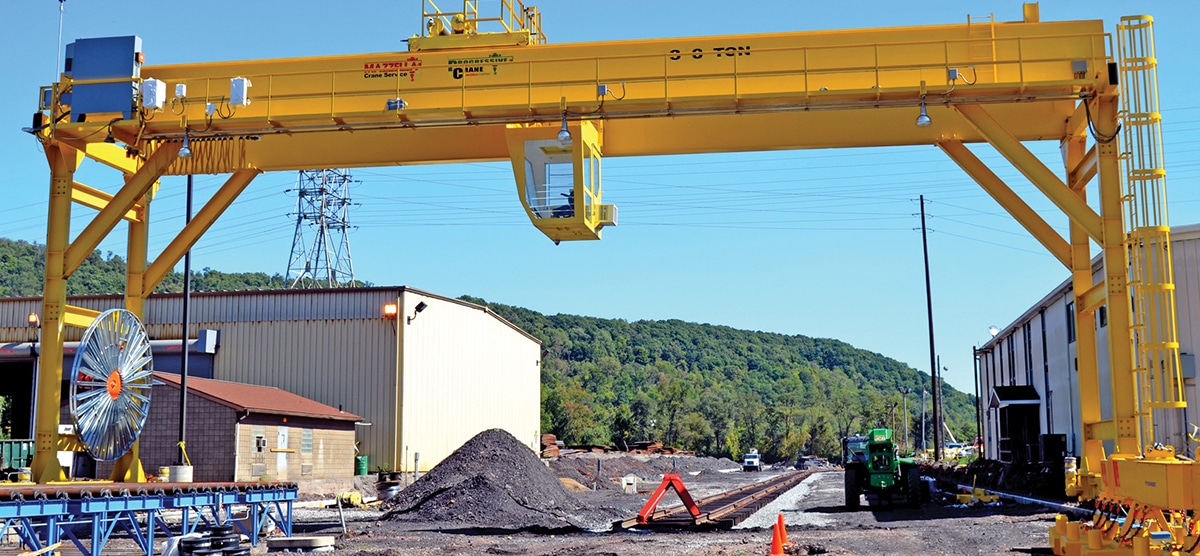
A gantry crane is similar to a bridge crane, but instead of moving on suspended runways, the crane uses legs to support the bridge, trolley, and hoist. These legs travel on rails that are embedded in, or on top of the floor or ground structure.
A gantry crane is ideal when you require a lightweight and quick knockdown crane for applications that require portability and corrosion resistance. They are also considered when there is a reason not to incorporate an overhead runway system and are most traditionally used in outdoor applications where full beams and columns can’t be installed, or they can be used below an existing bridge crane system. Gantry cranes are commonly found in shipyards, railyards, special construction sites like where a bridge is being built, or in places like steel mills where overhead room may be an issue.
What is a Monorail Crane?
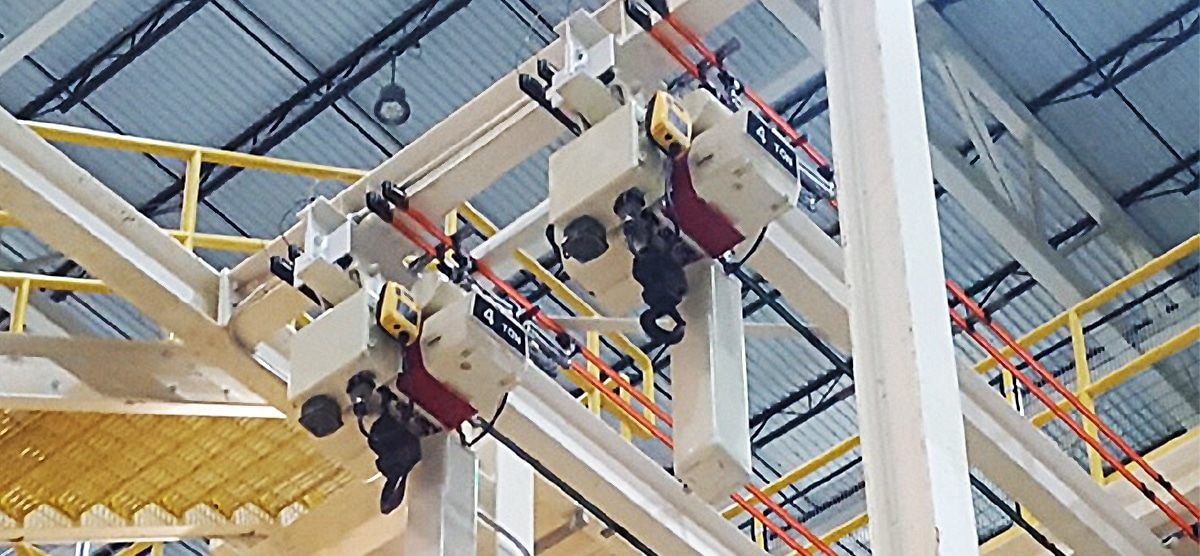
Most commonly found in a production or assembly line, this type of crane uses a trolley to carry the hoist along a single path. Monorail cranes do not utilize a bridge or girder design—instead, the trolley is designed to connect to an I-beam, often already built into the ceiling structure, and runs along the flat surface (flange) on the bottom of the beam. They can also utilize a configured support structure as well.
Material can be run back and forth in a straight line, or the rails can be designed with curves, branches, switches, and with changes in elevation. Monorail cranes follow a singular path and are designed for lifts that do not require the side-to-side trolley movement provided by the bridge in an overhead or gantry style crane.
What is a Jib Crane?
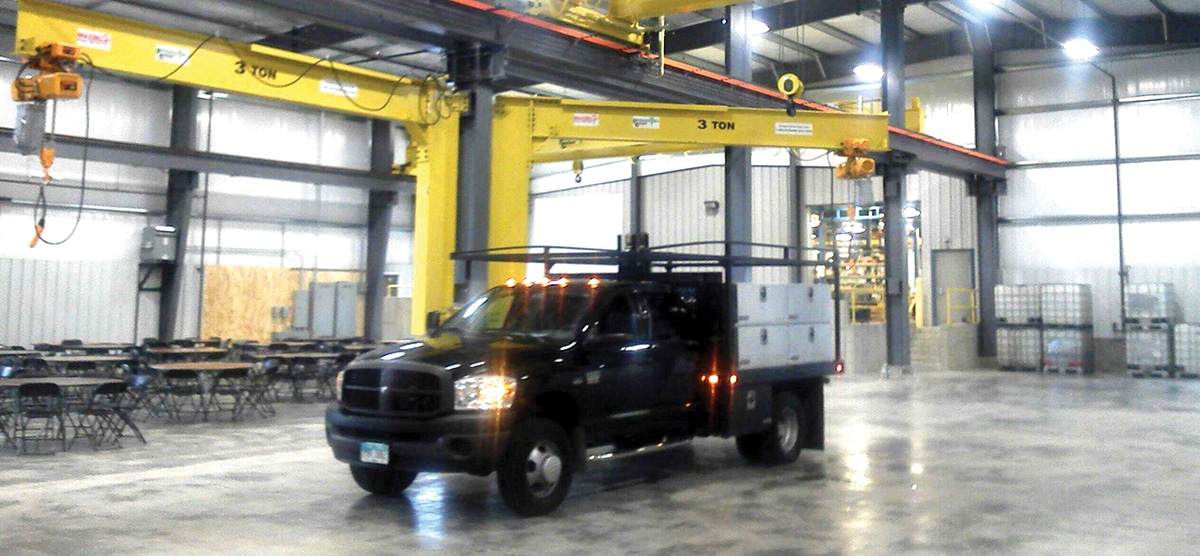
Jib cranes are space-saving, economical, and are ideal for jobs like maneuvering or moving items for assembly within a smaller radius. They can typically offer 180-360° of rotation, and even small ones can hoist several tons of material.
What is a Workstation Crane?
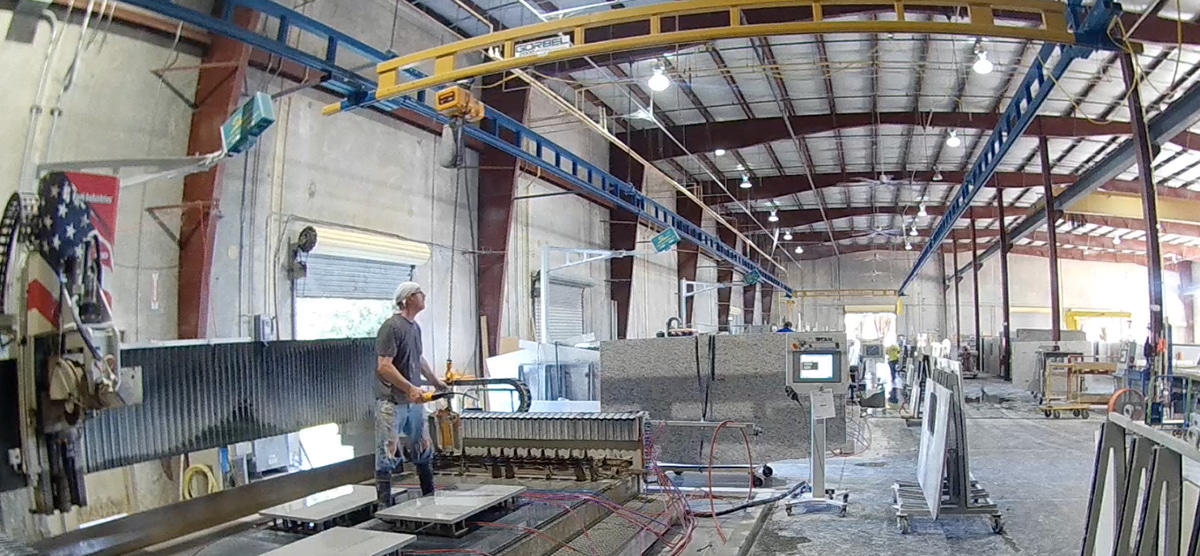
Workstation cranes are designed to allow the operators an ergonomic means of moving or lifting loads with limited effort in a smaller size work area. They’re typically lighter-duty systems—lifting materials from 150 lbs. up to 2 tons in capacity. They’re designed for repetitive lifting of loads, positioning of loads, increasing worker productivity and ease of work flow.
They can be built and installed easily using a modular design for greater flexibility and do not require an existing support structure for installation.
» Learn More About the Different Types of Overhead Cranes!
» Back to Menu
Section 4
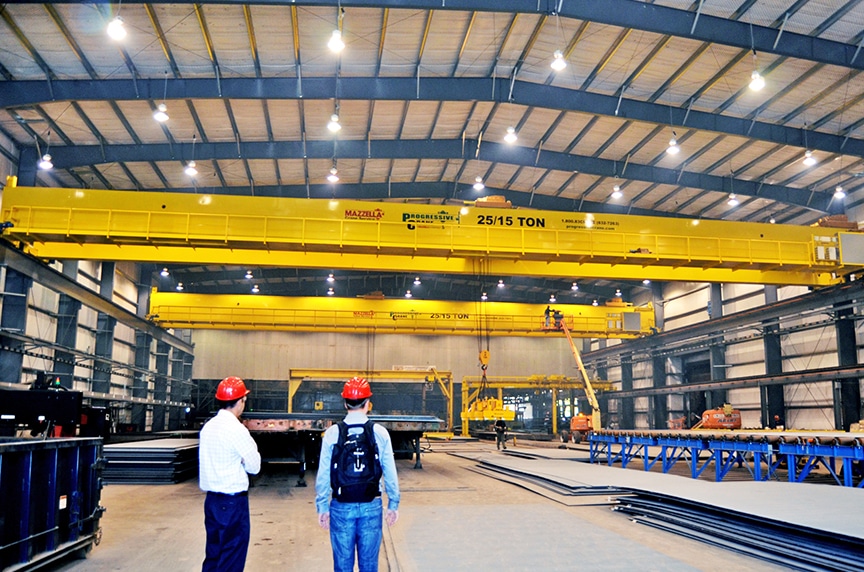
Purchasing an Overhead Crane: From Consultation to Installation
Understanding the process and expectations of buying an overhead crane—from the first contact with an overhead crane manufacturer, through the consultation and quote processes, and all the way up to installation. If you’ve determined that your business can benefit from the installation of a new system, then you’re probably in the beginning stages of researching companies who make or build overhead cranes.
An overhead crane is a complex and expensive piece of equipment. Prior to providing financing, your bank may want you to meet with a couple of different manufacturers to receive multiple quotes on the design and installation of a crane system. Even if you aren’t financing your new crane equipment, it’s still a good idea to bring in a couple of different companies to look at your facility and provide a scope of work and provide their expert opinion on the right crane for your business’ needs.
First Contact with an Overhead Crane Manufacturer
So, you’ve done your research, and you’re ready to take the next steps and bring in a couple of different overhead crane builders to come to your facility and bid on the project. If you filled out a contact form on a manufacturers’ website, then a salesperson will reach out via email or telephone to establish contact, introduce themselves, and learn about the following:
- Who you are and what you do
- Who your company is and what your business does
- The different types of industries you serve
- Your current lifting or material handling capabilities and any problems, or inefficiencies, that you’re currently experiencing
The next step will be to schedule a time and day for them to visit your facility. They’ll typically want to schedule a time to come out when production is up and running—so, don’t worry about scheduling a consultation on the weekends or during off-hours.
It’s actually more beneficial to their sales team to see what equipment is currently in use, see how it operates, and see where it’s located in the building. This helps them to understand how they might fit a new crane system into your building’s existing infrastructure and cause as little disruption to your existing processes as possible.
What Happens During an Overhead Crane Consultation?
Most often, these types of meetings are scheduled with your company’s Maintenance Manager or Production Manager and can last between 30 minutes to an hour. When the sales representative arrives, they’ll want to get right out to the production floor to get a quick tour of your facility, see how your production processes currently work, and get an understanding of the building’s floor space, support structures in place, and the size of the crane that they will be building.
During their time with you, they’ll be asking you a number of different questions—most likely filling out a form or spreadsheet with specifications, measurements, and observations. Some of the necessary information that they’re gathering to provide a quote can include:
- A description of the lifting application and the environment
- Existing cranes in facility—quantity, brands, capacities of existing equipment
- Total number of cranes needing to be installed
- Crane capacity / max hoist capacity
- Number of picks, or lifts, per hour
- What percentage of lifts will be at capacity?
- Span, or length, of crane and runway system
- Hook height / total lift height required
- Power supply (480V, 230V, etc.)
- Radio controls – yes / no?
If the salesperson can provide as much detail as possible to their team of estimators and engineers, then they can ensure that their team has a full understanding of the project and they can spec out and design a crane that is suitable for your unique building and lifting requirements.
Once the salesperson has gathered all of the information needed to design an overhead crane system for your facility, they’ll head back to regroup with their team and begin the quotation process for your crane installation project.
What Happens After the Overhead Crane Consultation?
There are all different types of overhead cranes, and the turnaround time of the quote can vary depending on the type of crane, complexity of the crane’s design, and what service classification it falls under:
- Simpler cranes like jib cranes and workstation cranes have a quick turnaround time—manufacturers can typically turn a quote around for a jib or workstation crane in 1-3 business days.
- A simple modular crane with a base trolley, hoist, and bridge design may take 5-7 business days to produce a quote.
- A quote for specially-designed process cranes, or cranes with extra engineering built-in, can take 10-14 business days, or even a month, to produce for projects with a large number of cranes or distinct characteristics.
A quote for an overhead crane includes the price for the full scope of the project—including all costs relating to:
- Project management
- Engineering and design of the overhead crane system to meet customer specifications and ASME guidelines
- Sourcing of all overhead crane parts and components
- Design and manufacturing of new runway systems (if runways don’t exist or existing runways can’t be utilized)
- Any disassembly and removal of existing overhead crane systems
- Installation of new system and load test at time of electrical start-up
- Timeframe / lead time to complete the project
- Payment terms
Additional charges related to tax, freight, and any fees associated with obtaining permits may or may not be built into the quote, so make sure that you clarify whether there are any additional costs that are not included in the quote.
» Learn More About the Overhead Crane Design & Consultation Process!
» Back to Menu
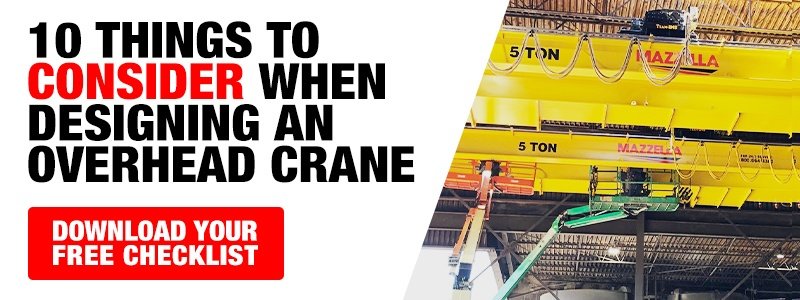
Section 5
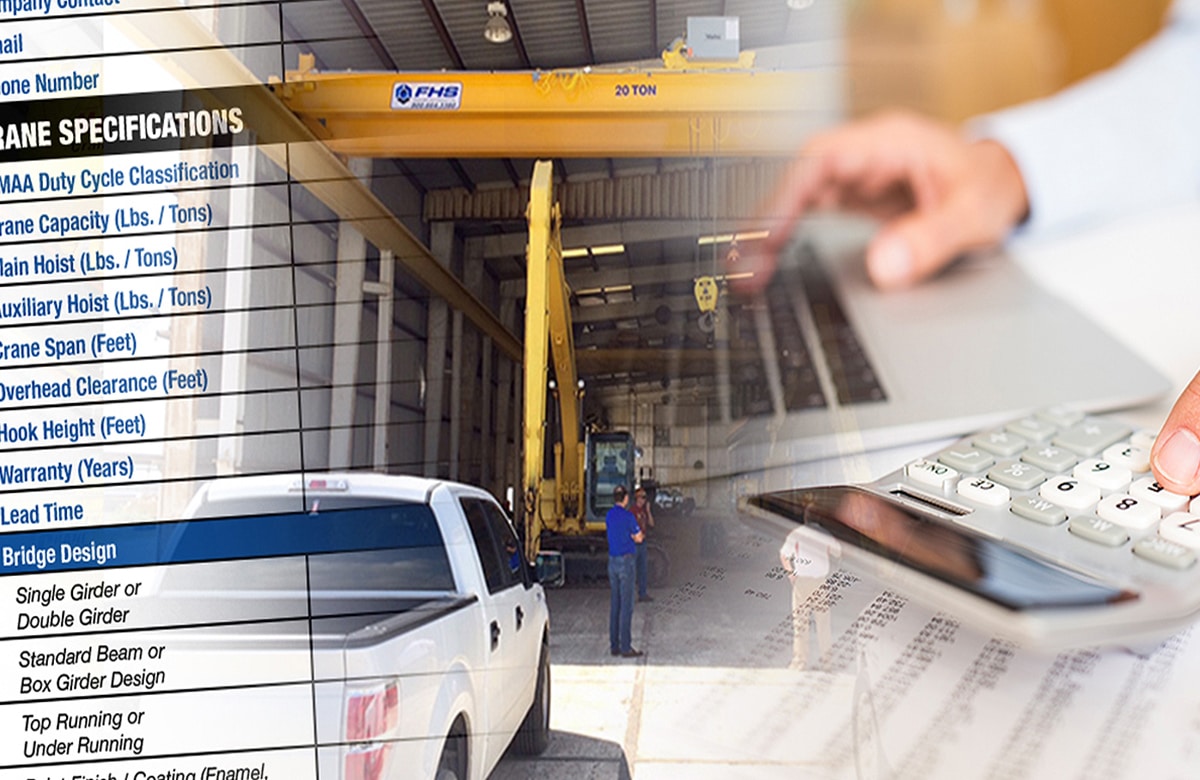
How to Compare Overhead Crane Quotes
Price shouldn’t be the only factor when selecting an overhead crane manufacturer to partner with. Read on to get a comprehensive understanding of a project quote and what criteria you should use to compare multiple quotes.
Partnering with an overhead crane manufacturer is a big decision and one that should not be taken lightly. The design, manufacturing, and installation of an overhead crane system is an enormous investment, but a necessary one if you want to improve your company’s efficiency and workflows.
Get Multiple Quotes for an Overhead Crane Installation
If you’re looking to finance your overhead crane equipment, then your bank may require you to get at least three bids on the project. Even if you know you won’t be financing the equipment, you should do your due diligence and have a couple of different crane companies look at your facility, provide a scope of work, and provide their expert opinion on the right overhead crane for your business.
Gain Perspective
Getting a couple of fresh sets of eyes on the project will help provide different options and opinions on the project. Each overhead crane builder may have a different idea or approach to go about solving your lifting and material handling challenges.
Keep Costs Competitive
By having multiple manufacturers bid on your project, you will get a better sense of the true cost of buying and installing a new crane system. Also, if a company knows that they aren’t the only ones bidding on the project, they will tend to provide a more comprehensive and competitive estimate and may be more willing to negotiate on the final purchase price to get your business.
How to Find Overhead Crane Manufacturers
It’s important to find the right company to partner with for your overhead crane project. There are a couple of different resources that you can use to research manufacturers including referrals, industry events or trade shows, and utilizing the internet for research.
Ask for Referrals
Utilize industry connections to find out if current customers, vendors, or suppliers utilize overhead lifting devices. Find out who they worked with and if they were happy with the partnership.
Attend Industry Trade Shows or Events
Take a few minutes to visit the trade show’s website prior to the event and look at the list of exhibitors. You may luck out and find out that an overhead crane company that specializes in lifting equipment is already scheduled to exhibit at an industry show you’ll be attending.
Do Your Research Online
Use Google or other search engines to find local crane manufacturers that you might be able to work with. This could result in significant cost-savings to coordinate travel and freight when it comes time for the installation.
What Factors Affect the Cost of an Overhead Crane?
When a crane manufacturer comes on-site for a consultation, they’ll try to identify your specific lifting challenges, as well as evaluate your facility to get an understanding of the building’s floor space, support structures in place, and the size and capacity of the crane that they’ll be building.
Each of the following specifications will affect the cost of an overhead crane’s design and installation:
- Total Number of Cranes
- Capacity
- Lift Height
- Number of Lifts Per Hour
- Hook Approach
- Electric, Manual, or Pneumatic Power System
- Operating Environment
- Operating Speed
- Controls
- Span
- Runway Location
How to Compare Overhead Crane Quotes
Once you’ve gone through the consultation process, a crane manufacturer will re-group with their team of estimators, engineers, and draftsmen and begin putting together a comprehensive proposal.
Keep in mind that price should never be the only factor when selecting a company to partner with. We suggest evaluating the following things when comparing overhead crane quotes so that you have a comprehensive idea of what you’ll be spending on the design and installation:
Project Specifications
For a project of this scale, it’s so important that each company bases their quotes off of the same information and specifications so that you can make a true side-by-side comparison of each company’s capabilities and pricing.
Warranty
Make sure you have a clear understanding of the manufacturer’s warranty policies on workmanship, components, and materials.
Incidentals
Any additional charges that may not appear int he quote, including material surcharges, freight, tax, permit fees, etc.
Follow-Up
Did someone follow up to make sure you understand and are comfortable with the breakdown of costs?
Timeline
Have they committed to meeting your project’s specific time frame and window for installation?
References
Are they willing to provide references that you can reach out to? Find out if other customers were satisfied with the quality of work, commitment to keeping the project on track and within budget, and delivery of crane to agreed-upon specifications.
» Learn More About Comparing Overhead Crane Quotes!
» Back to Menu
Section 6
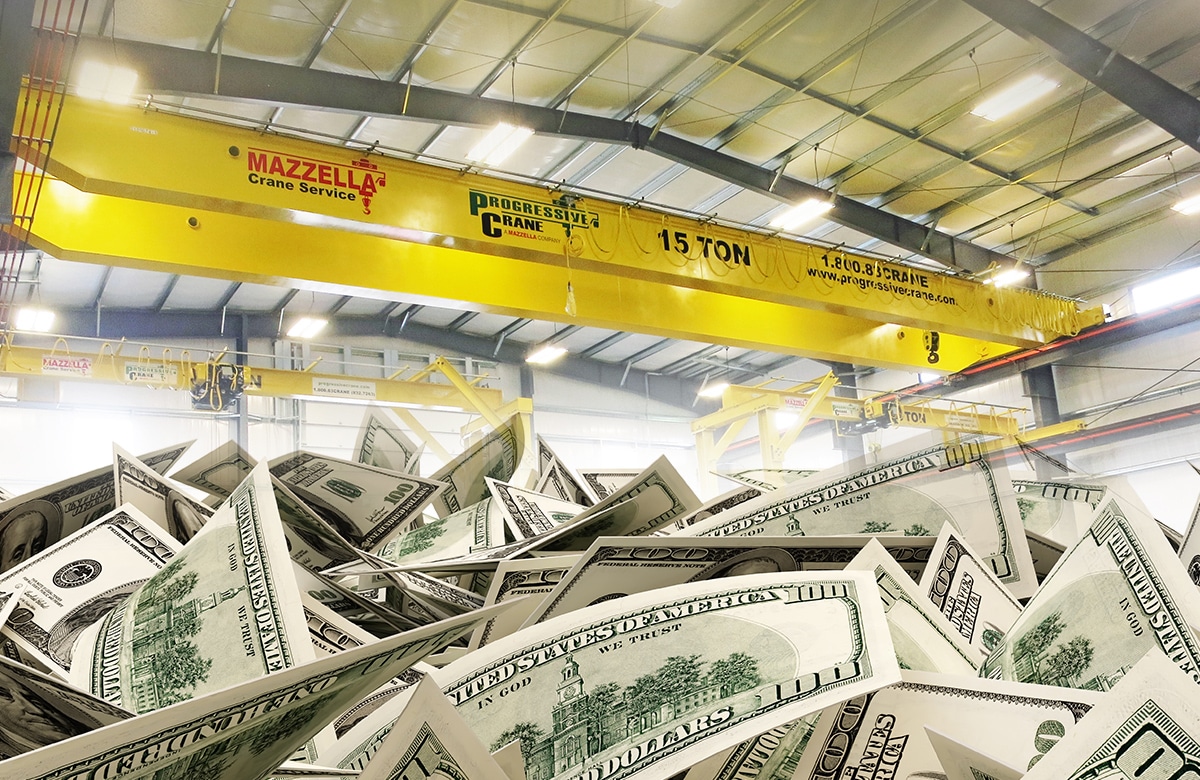
What is the Cost of an Overhead Crane?
The type of crane, the span, the capacity, the duty cycle, operating environment, and any additional building or structural considerations can all add to, or lessen, the cost of an overhead crane.
If you’re just starting your research, we understand that the process of buying and installing an overhead crane in your facility can seem somewhat overwhelming.
Every day we get customers who reach out to us to quote a new indoor or outdoor crane project. They may be moving into a new building, replacing an old or outdated piece of equipment, or may be buying an overhead crane for the first time and are looking to expand their business’ material handling capabilities.
What Affects the Price of an Overhead Crane?
To make sure that you get the right type of crane for your business, you should be ready to address the following information when you contact an overhead crane manufacturer to bid on your project:
What Type of Overhead Crane Do You Need?
The complexity of the crane’s components required to operate the crane, the engineering required to design the crane, and the application (industry or materials being lifted) will determine what type of crane you will need.
What is the Span of the Overhead Crane?
The span, or distance between the runway rails, is one of the biggest contributing factors to the cost of an overhead crane. The longer the crane’s span, the more material is required to build the crane girders. This added material increases the crane’s weight, which will also increase the cost of the runway, if required.
What is the Capacity or Maximum Rated Load?
Capacity is the maximum load which may be applied to the crane in a particular working configuration, and under a particular condition of use.
What is the Service Classification or Duty Cycle?
There are six different classifications of overhead cranes, specified by the Crane Manufacturers Association of America (CMAA) based on the following criteria:
- How frequently will the crane be used?
- How quickly will the crane need to transfer equipment or materials?
- How many lifts per hour will the crane need to perform?
- Will the crane be needed for regular or frequent service?
- How far does the crane need to move material in your facility?
- What is the average rated load of the materials that will be moving?
- How often will the crane be making lifts at full capacity?
- In what type of environment will the crane be operating?
What is the Operating Environment?
A severe, obstructed, or dangerous operating environment where the crane will be installed and running, will affect the cost in several different ways.
Environmental factors such as high heat, the presence of chemicals or fumes, steam, dust, or excess moisture can require special metal coatings to protect and enhance the operating life of the crane. The individual components of the crane will also need to be sourced to ensure that they can hold up and withstand the operating environment.
What is the Length of the Runway?
The runway length is the largest contributor to the runway cost itself. This length can also play into the cost of the crane. If you need to make multiple picks per hour and have a long runway, then you may need a faster trolley and hoist to move up and down the runway quickly. The additional speed may require the components of the crane to be sized to a higher capacity.
What are the Building or Structural Requirements for Operation or Installation?
If a bridge crane is being installed in a new construction facility, then typically the runway beams will be installed during the construction process, and the crane manufacturer won’t need to include the runway structure in the quotation process.
If a crane is being retrofit into an existing building, there will be added costs for the design, fabrication, delivery, and installation of the crane’s runway system. Most crane manufacturers don’t offer in-house structural repair or certification services, so you’ll also have to consider any additional costs related to having concrete contractors or structural engineers provide a consultation of your facility.
» Learn More About the Cost of Buying and Installing an Overhead Crane System
» Back to Menu
Section 7
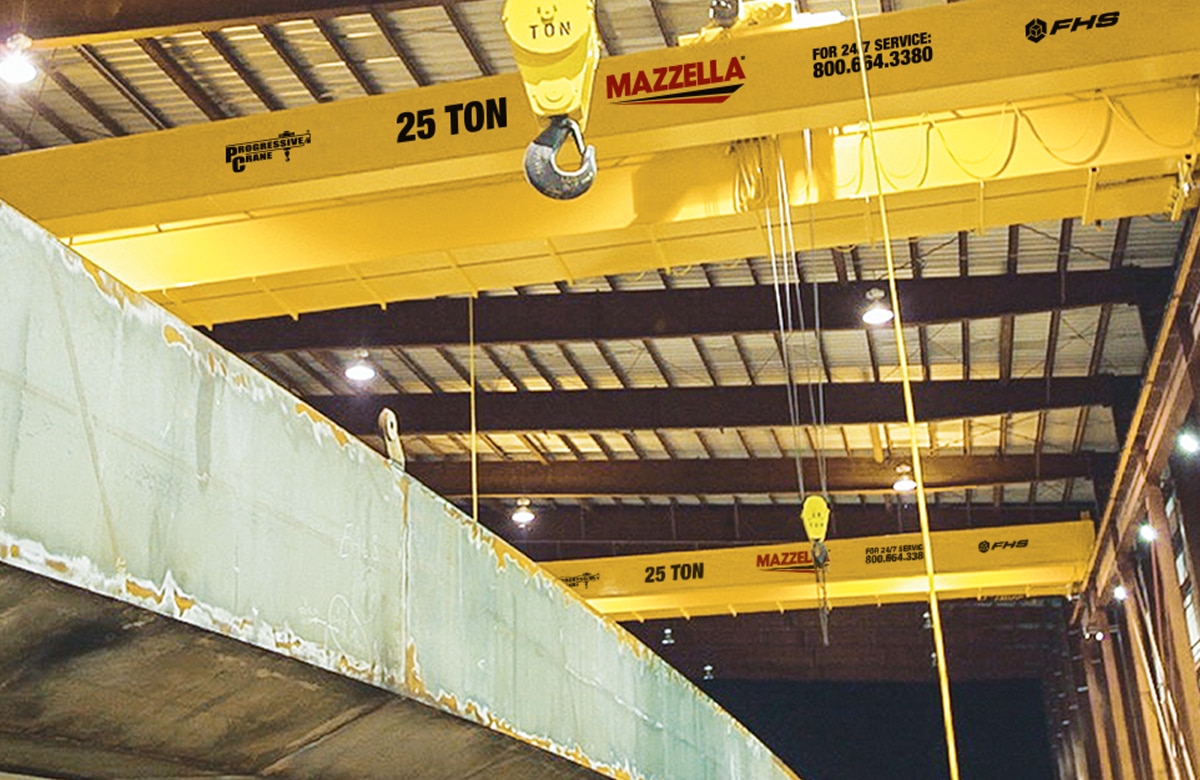
Top 10 Reasons to Consider Financing Your Overhead Crane Equipment
As you can see, investing in an overhead crane system can be one of the most useful and utilized pieces of equipment you can add to your business to increase production, workflows, and bring in more profit. However, paying the full amount of money upfront can be a significant investment that may seem out of reach for many small to mid-sized business owners.
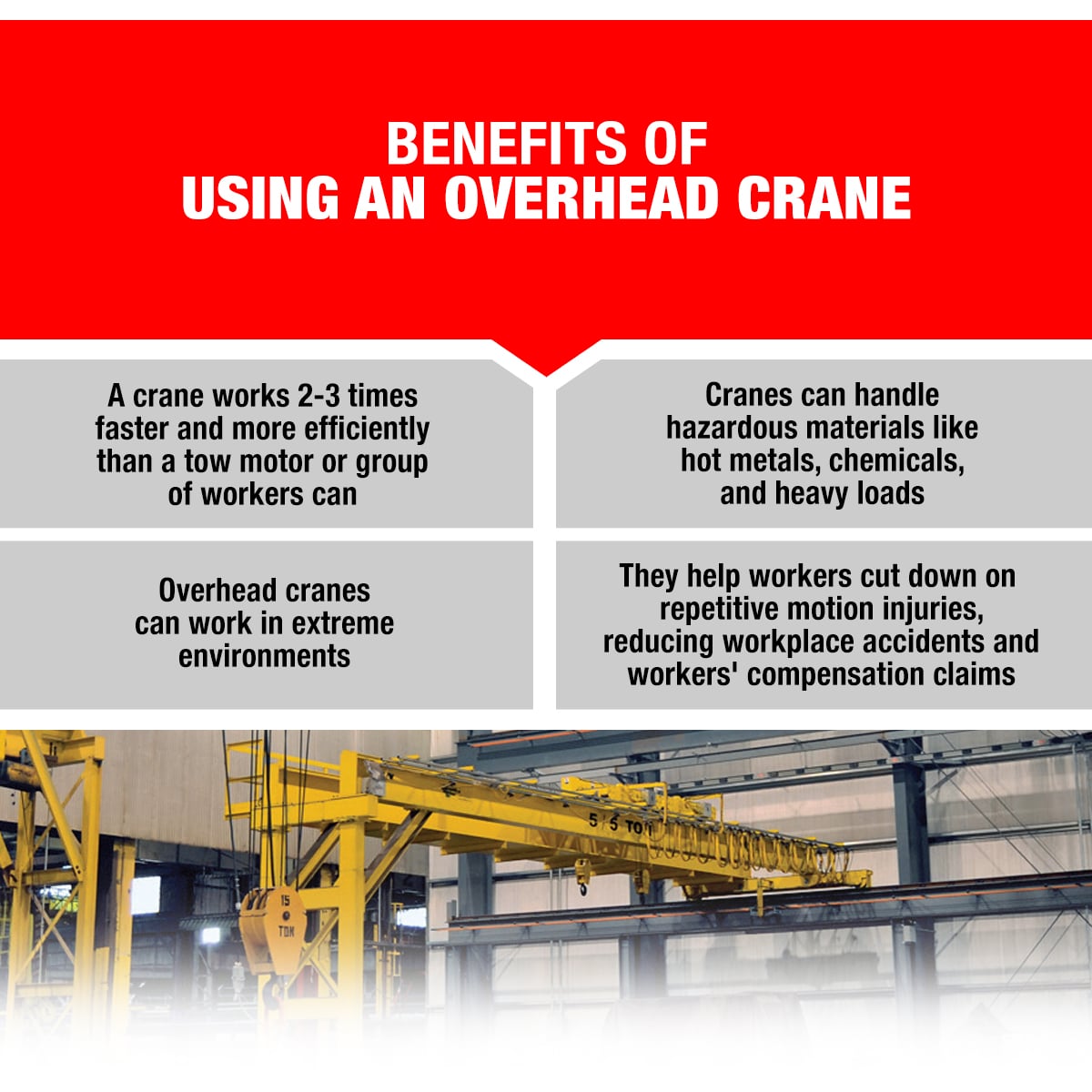
One of the concerns that many of our customers have is how to pay for the crane equipment that they know will increase their productivity and save them money in the long run. In this article, we’re only going to discuss securing a loan from a lender to purchase a new overhead crane system.
Typically, a crane would not be a piece of equipment that would be leased because the installation of a bridge crane, jib crane, or workstation crane is a semi-permanent to permanent operation tied into the structure of the building. Removing and replacing the crane every couple of years would not be a feasible option for most businesses.
Top Ten Reasons to Finance an Overhead Crane
1. Improve Cash Flow
When you finance a new crane system, you don’t have a significant amount of cash tied up in your equipment. You’re free to use your available cash for other investments that will help to grow or improve your business, produce revenue and income, and ensure that the crane system that you purchase improves your efficiency and earns more profit.
2. Include “Soft Costs” in Your Financing
Many lenders will allow you to roll in and include 100% financing for other “soft costs” associated with the cost of new equipment, including things like:
- User or operator training
- Freight and delivery
- Any modifications or additions to building structure
- Installation costs
- Equipment maintenance or service agreements
3. Preserve Other Lines of Credit
Financing your crane equipment leaves other credit options available from your bank or other sources to take advantage of future opportunities to invest in the growth and development of your business.
4. Flexible Financing
A business’ income tends to see ups and downs over the course of a year. Some lenders will customize a lending plan unique for their customer’s business that’s built around their needs and sets them up for success. This can include a combination of options including varying monthly payments to match seasonal ebbs and flows in revenue, as well as varying payments based on accounting and tax schedules.
5. Stabilize Your Monthly Expenditures
By setting a fixed or variable monthly payment, you set yourself up for more accurate budgets and forecasts because you know exactly how much you’ll be paying towards your loan each month. This also gives you a better understanding of what you can and cannot afford when it comes to payroll, operating expenses, inventory, equipment, and marketing and sales support.
6. More Equipment Options Available to You
Because the monthly payment is a small portion of the total cost of the equipment, financing allows a greater amount of equipment for a given dollar allocation. This means you may be able to plan more for the future and select a higher-end crane system that allows room for your business to grow into its full capabilities and capacities.
7. Benefit from Inflation
For a fixed-term payment, if you already owed the money before inflation occurred, the inflation actually benefits the borrower. Because you now have more money available to you, and your payment is still the same, this can result in less interest for the lender if you use the extra money to pay off the loan early.
8. Upgrade or Modernize Crane Equipment You Own
An advantage to owning an overhead crane system is that you can always upgrade or modernize the components of your crane to extend the investment in the equipment, should your production or material handling needs change down the road.
Older cranes can be improved to a higher level of productivity and safety through a modernization upgrade and refurbishment program, including upgrades to:
- New and more efficient hoists and drives
- Increased capacity
- Add or upgrade speed and motion controls
- Cab to pendant conversions
- Infrared and radio remote controls
- Electrification systems
- Major mechanical components
9. Shop Lenders for Competitive Rates
Do your due diligence and solicit multiple offers from different lenders to find the best loan for your business. By contacting multiple lenders, you can select a lender to partner with based on the following criteria:
- Most competitive interest rates
- Terms
- Willingness to provide flexible or varying payments
- What other “soft costs” can be included in the loan
10. Pay Off Your Crane Equipment Early With No Penalties
By financing your crane equipment through a loan, you receive ownership of the crane from the start and pay back the cost to the lender each month. The nice thing about financing is that most banks loan out the money without prepayment penalties. So, if you’re able to pay off the loan before the agreed-upon terms, it won’t cost you anything extra and will save you a significant amount of money in interest payments.
If you’ve been researching the right type of crane for your business, then you know that the cost of an overhead crane can add up quickly based on the span, capacity, and any other specialized engineering or custom specifications required for your lifting needs.
By acquiring a loan, you can add the technology that you need today without dropping a large sum of cash and potentially jeopardizing your business’ future earnings and investment opportunities. Instead, you’ll have a predictable monthly payment that will allow you to accurately budget and forecast. This gives you the freedom to make other investments that will grow your business, produce revenue and income, and ensure future profits.
» Learn More About Financing an Overhead Crane System!
» Back to Menu
Section 8
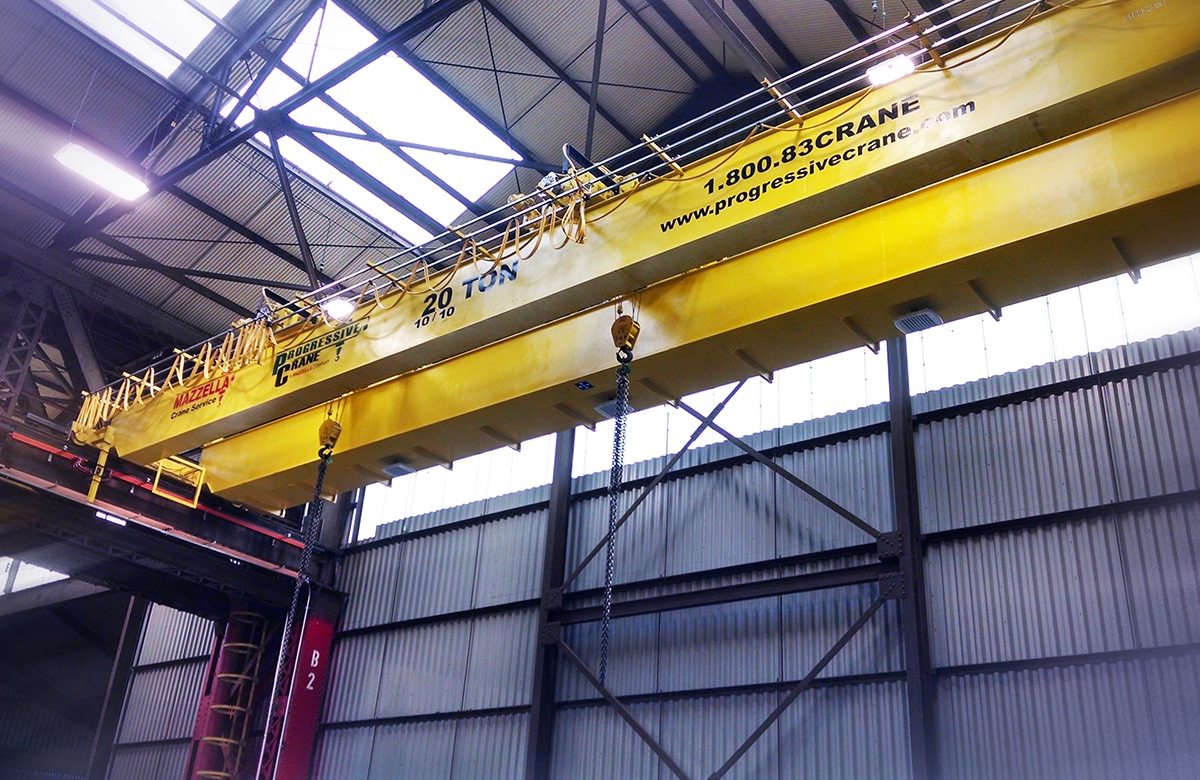
Overhead Crane Installation Procedures: From Conception to Completion
So here we are … you’ve done all of your research, decided on the type of crane you need for your facility, selected a manufacturer to partner with, signed an agreement, and cut the deposit check. So what happens next? Installation.
Whether this is your first time going through an overhead crane installation, or you’ve gone through multiple crane installations, we hope you can learn something to help keep your next install on schedule, within budget, and your workers safe.
What Occurs Before the Installation of an Overhead Crane?
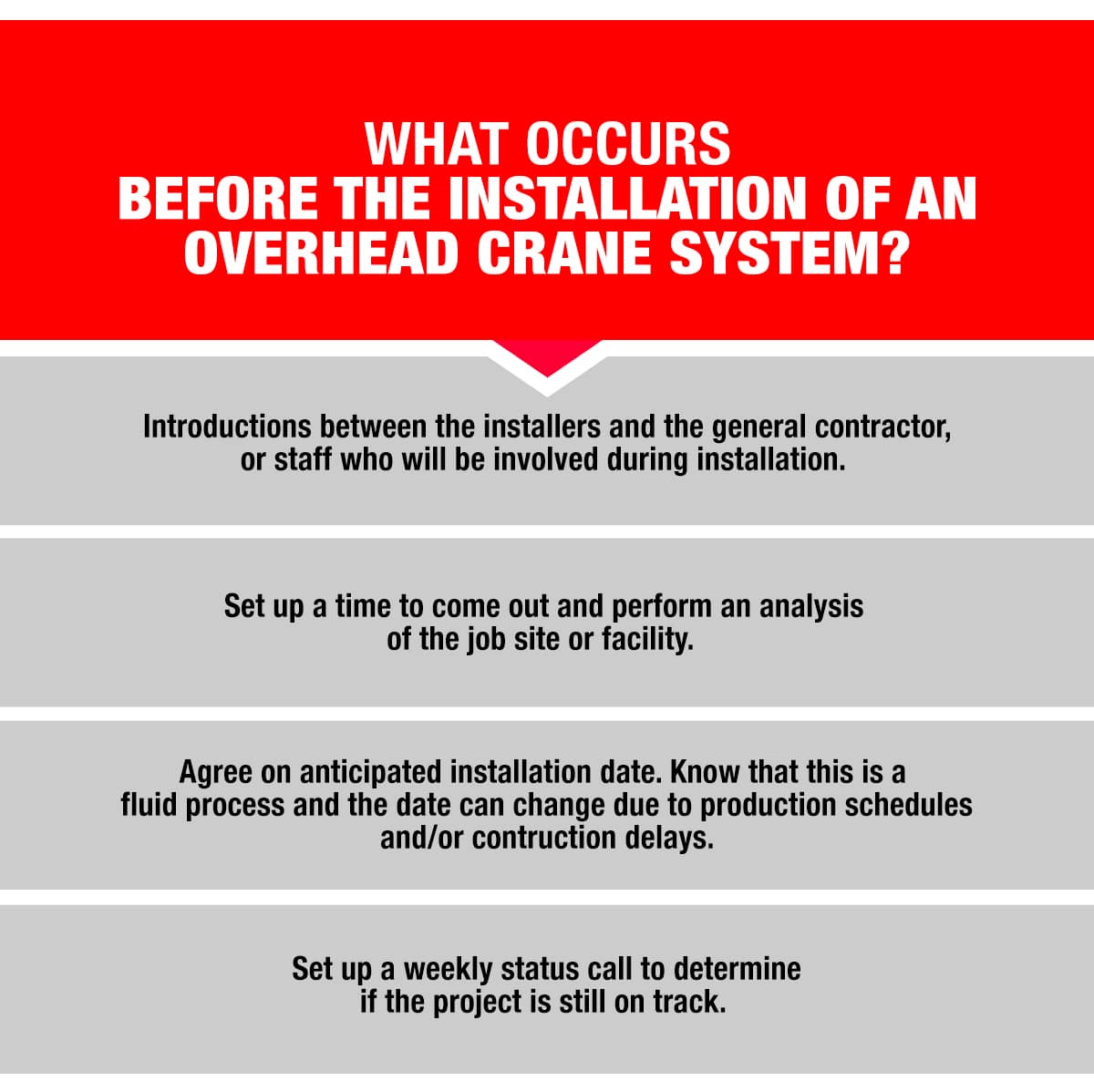
In the quote, the crane installer will provide a window or time frame that they think they’ll need to complete the crane installation. This can range anywhere from 2-10 business days, to a longer time period for more extensive or complex crane installations. This estimated installation window will be consecutive working days—once they’ve brought the cranes, trucks, materials, and all installation equipment on-site, they can’t break up their time, or stop and re-start the installation, without significant increases to cost of the crane installation.
Once a purchase order is received, the overhead crane manufacturer will begin building and assembling the crane itself—a process that can take anywhere from 2 to 12 months.
About a month out from the expected completion date, the installer will reach out to the customer or general contractor to establish contact with the necessary parties. During this initial contact the installer will introduce themselves, set up a time to analyze the job site or facility, schedule an anticipated installation window, and set up future calls or appointments to make sure everything stays on track.
Evaluate the Scope of Work
Once you’ve signed an agreement to purchase new crane equipment, the installer will receive a copy of the purchase order. Once they receive the purchase order, your installer will contact you and arrange to come to the job site and meet with your team. This meeting typically involves a Maintenance Supervisor or Plant Manager for an installation at an existing facility, or a General Contractor at a new construction site.
During this phase of the process, the installers will:
- Review any signed approval drawings and building prints
- Begin compiling a list of materials and equipment that will need to be brought on site for installation
- Identify where they can access the building or site to bring in equipment and materials with free and clear access
- Work with the General Contractor or Production team to get a clear picture of the timeline for installation and identify any issues that may cause delays
Review the Area Where the Overhead Crane Will Be Installed
During their site visit, the overhead crane installers will spend a good amount of their time reviewing the area where the crane will actually be installed. On a new construction project, they’ll start roping off the area to give the General Contractor an understanding of the area that they will need to be cleared out during the crane installation process.
For new construction, the installers will need to work with the General Contractor to understand the timing and installation window for:
- Electric and gas line installation
- Concrete or other masonry work being performed
- Overhead light fixtures
- Duct work / roofing work
- Plumbing
In an existing facility, the installers will make note of any obstacles they may need to consider during the course of the installation, including:
- Identifying the type of flooring (concrete, dirt, etc.) and also understanding the load requirements for bringing in heavy-duty equipment and trucks
- Identifying load requirements for structural support beams for existing runways
- What equipment or machinery will be operational during the installation process and what employees, if any, will be working near or around the area?
Identify Potential Hazards
The overhead crane installer will need to identify any and all potential hazards so that they can plan and prepare their team accordingly. Different types of hazards may require specialized protection (PPE) for their team, specialized permits, and other special considerations to make sure that the crane installation is performed safely.
These are the types of hazards that an overhead crane installer will look to identify prior to the crane installation:
Energy Sources
Overhead electrical or gas lines, power/conductor bars, lighting fixtures, etc.
Traffic Sources
Forklifts, manlifts, trucks and semis, personal vehicles, pedestrian walking paths, foot traffic, etc.
Environment
Presence of excessive heat, hot metals, chemicals, etc.
Working at Heights
Anything over 4 feet, ladders, scaffolding requires proper fall protection
Hazardous Energy
Identify any equipment requiring lock-out/tag-out per OSHA 1910.147
Any Additional Hazards
Identified by the customer or installer
Review Details for the Crane’s Runway System
For an existing system, the installer will want to verify the span measurement per the approval drawing. They will also inspect the runway beams and any type of electrification system to make sure that everything is in proper alignment. A runway system that is out of alignment can cause operation problems and cause premature wear on the components of an overhead crane.
For a new installation of a runway system, the installer will review all approval drawings and specifications, verify measurements and support loading ratings, and also identify any process lines, machinery, or other items that may interfere with installation. The installer will also need to verify that the crane will be able to pull power from the building and all electrical work will be complete prior to the scheduled install date.
Commit to the Installation Date
Once you get within an agreed-upon window prior to the scheduled installation date, everything begins moving full speed ahead in order to coordinate the logistics, transportation, and scheduling of workers, material, and equipment.
Make sure that you have a clear understanding of the “point of no return” for your overhead crane installation. Once the process gets rolling, there’s really no way to stop it as the crane and installation equipment is probably en route to your facility. Also, consider all of the different people that will be involved in the installation process and all of the effort involved to coordinate their schedules:
- Truck drivers
- Mechanical installers and mechanical assemblers
- Riggers, who will do the majority of the unloading and setting up of equipment
- Crane operators
- Electrical specialists
- Crane technicians
Your agreement or contract with the installer will specify that if any type of delay occurs within that 7-30 day cancellation window, you will incur significant charges related to paying employee wages, and rental of equipment. It is so important that you keep in constant communication with the crane installer and notify them immediately of any issues or concerns that could delay their installation time frame.
Load Test Your Newly Installed Crane System
OSHA requires that a rated load test be performed prior to the initial use of your overhead crane. Load testing can be performed using a variety of materials including concrete, steel, or water weight bags. Once the crane has been erected and installation is complete, the crane will need to be started up and load-tested to make sure everything is in working order. A third-party testing company may be brought in to perform the test and ensure that the crane will operate safely and productively.
» Learn More About Installing an Overhead Crane System!
» Back to Menu
